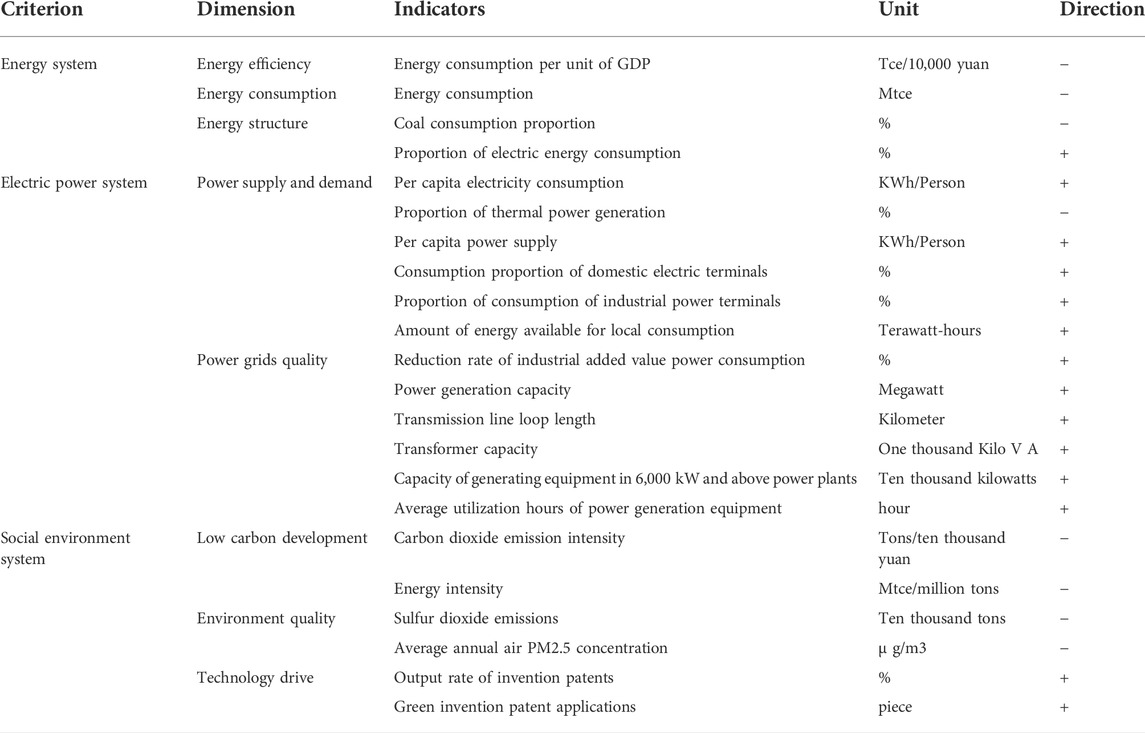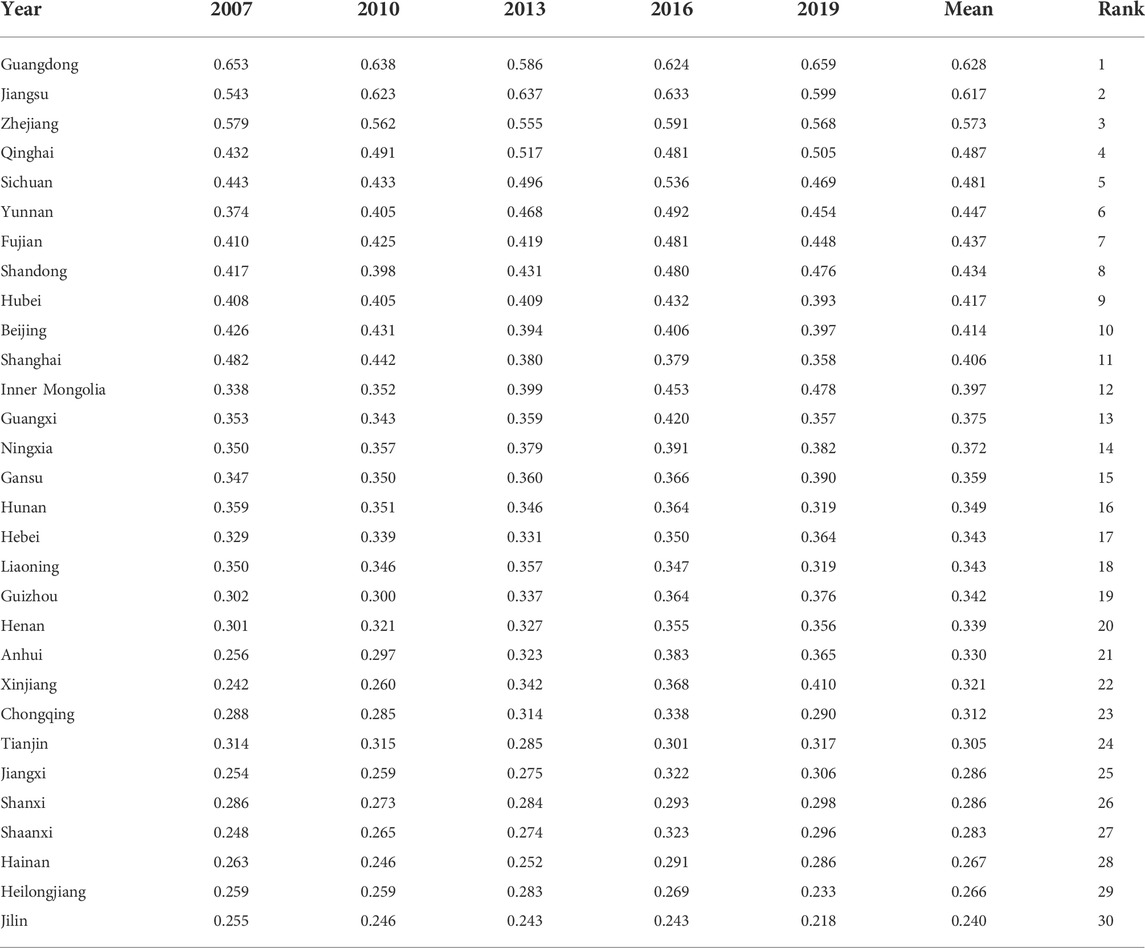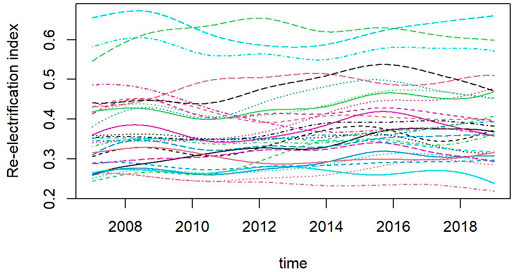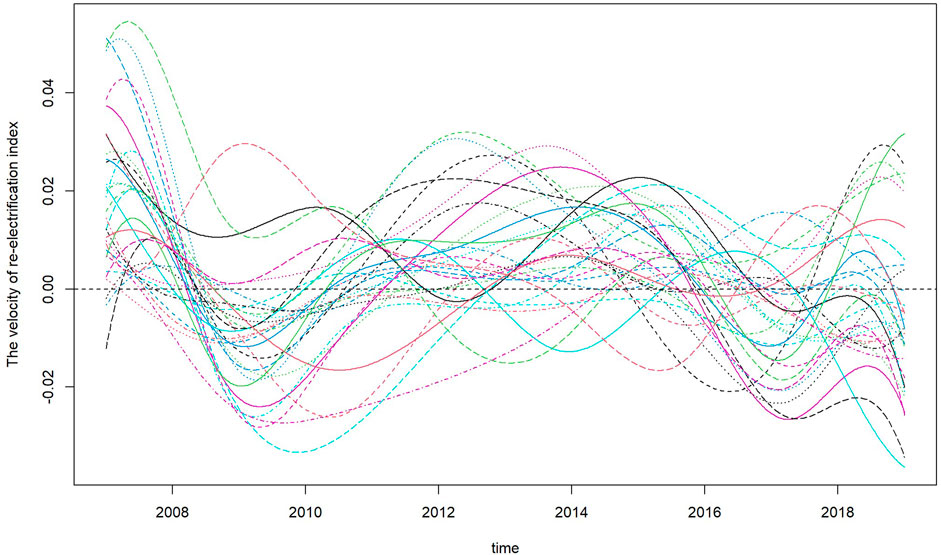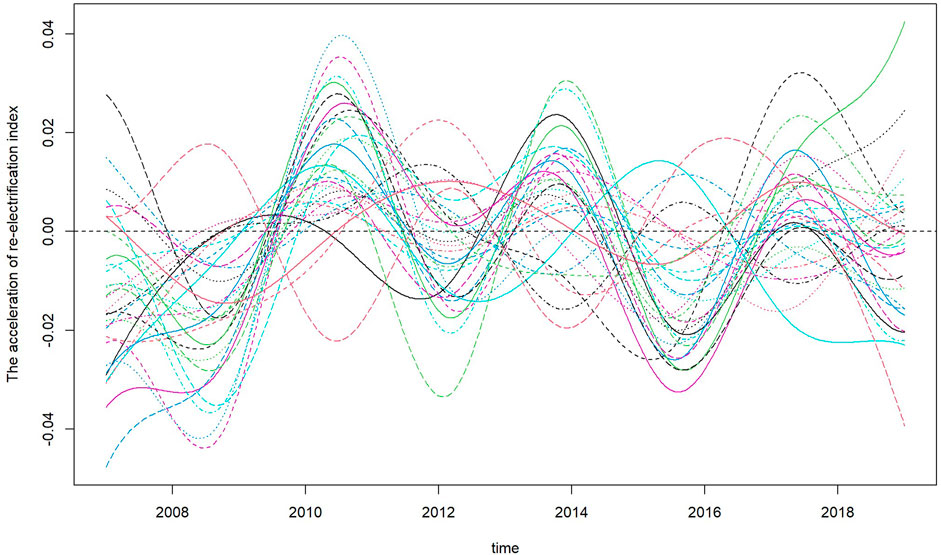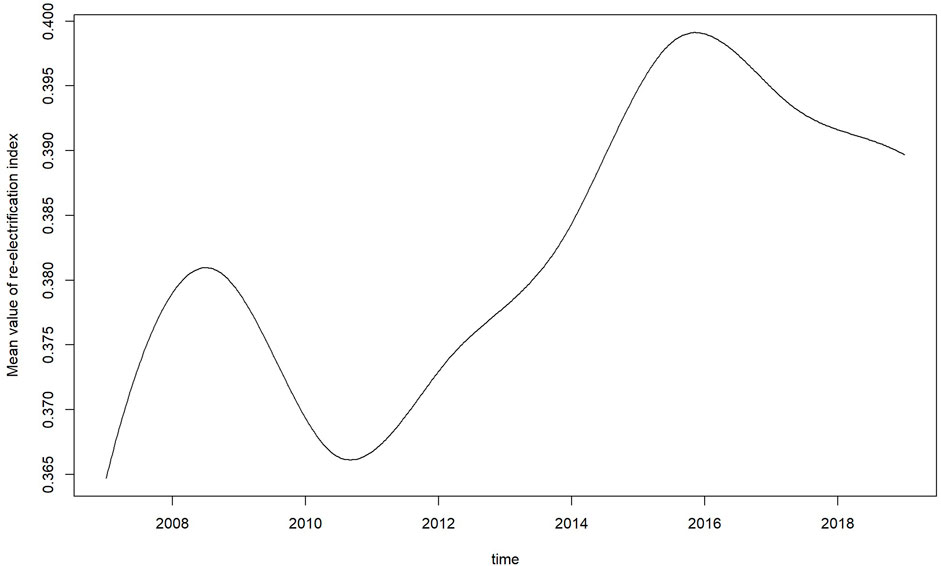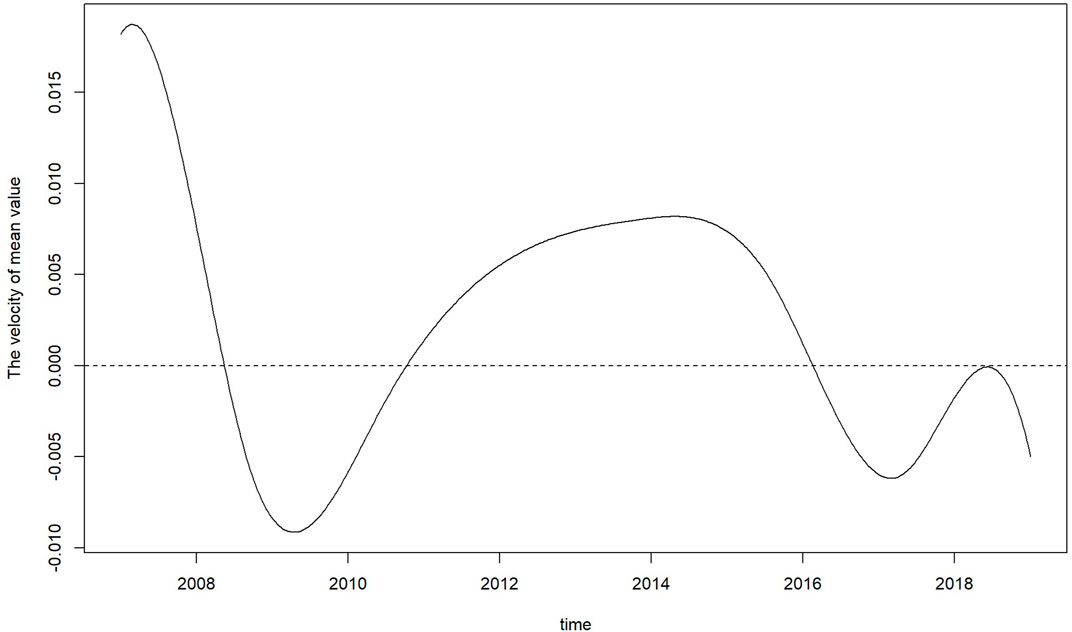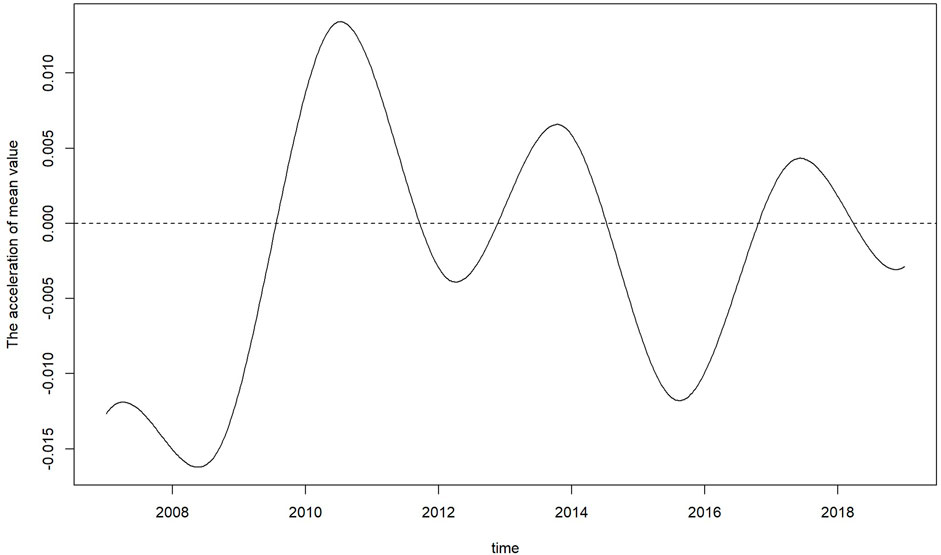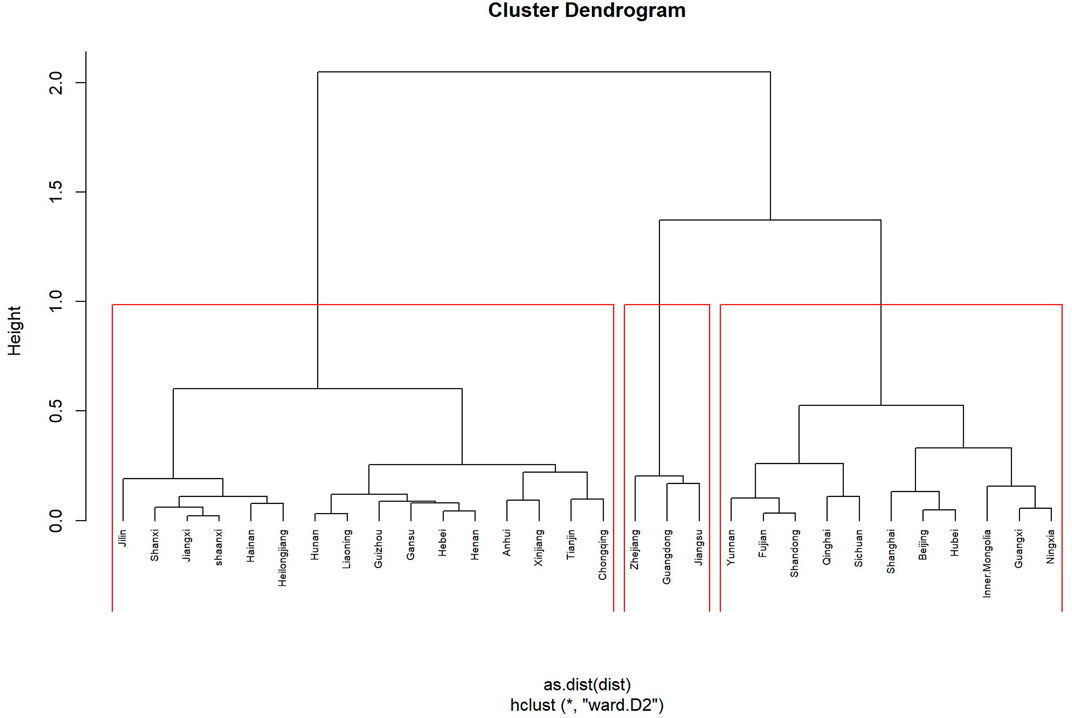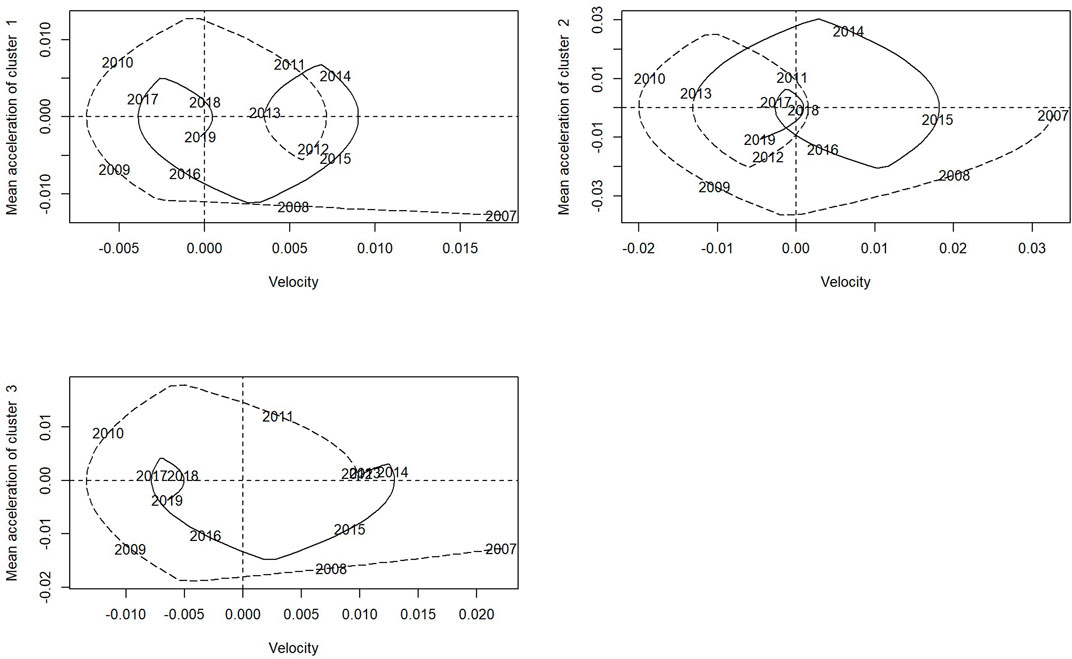- Electric Power Research Institute, Guangxi Power Grid Co., Ltd., Nanning, China
Electrification is currently the most mature technological path to carbon neutrality. However, the traditional measurement methods of the electrification levels cannot meet the development requirements of China’s electrification under the dual-carbon strategy. Thus, this study incorporated carbon constraints into the re-electrification-level evaluation system and evaluated the re-electrification level of 30 provinces in China from 2007 to 2019 using the entropy weight method. Then, the functional data analysis method was employed to further explore the dynamic variation rule of the regional re-electrification level. The evaluation results show that the top three provinces in the mean value of the re-electrification index are Guangdong (0.628), Jiangsu (0.617), and Zhejiang (0.573). The clustering results show that there are great spatial differences in the development of electrification in China. According to the fitted function curve, China’s electrification development can be roughly divided into the following four stages: uptrend, brief decline, sharp uptrend, and slight and steady decline. At present, China’s electrification is entering a new stage. To implement re-electrification further, the government and the power grid enterprises need to find the priority and breakthroughs under carbon emissions and environmental constraints. Our research results provide reference for the improvement of regional re-electrification levels in China.
1 Introduction
With the increasing environmental pollution and deepening energy crisis in China, the implementation of electric energy substitution and the improvement of electrification level are of great significance for the implementation of the national energy strategy and the promotion of clean energy development (Chang et al., 2019; Cai et al., 2020). On the one hand, in the face of changes in the international energy pattern and global energy transformation, comprehensively improving the level of electrification is an important way for China to effectively promote the energy revolution to solve problems such as energy security and environmental pollution (Chen et al., 2019; Cheng and Yao, 2021). On the other hand, serious environmental problems such as air pollution have posed great challenges to China’s sustainable development (Lin et al., 2021). The improvement of the electrification level of end-user energy sector will directly lower the consumption of fossil energy such as oil and coal, thus reducing pollutants and carbon emissions (Dennis, 2015; Dennis et al., 2016), thus contributing to the goal of carbon neutrality.
China is a major consumer of primary energy, and it still relies heavily on fossil energy (Du et al., 2021). Thus in 2020, China’s electricity consumption accounted for approximately 27% of total energy consumption, but China’s coal consumption still accounted for a large proportion of primary energy consumption, reaching 57.5%, which is higher than the international average level (Data Source: National Energy Administration). There is still much room for improvement in China’s electrification level, and electric energy substitution needs to be promoted in an systematic manner. Therefore, dynamically evaluating the electrification level of each region and formulating corresponding propulsion strategies have become one of the urgent problems.
There are two main ways to measure the electrification level of a country or region. One is represented by the proportion of power generation energy in primary energy consumption, reflecting the position of electricity in the whole energy supply system. The second one is represented by the proportion of electric energy consumption in terminal energy consumption, which reflects the dependence of economic and social development on electricity (Dong et al., 2017; Liu et al., 2020). With the proposal of carbon peak and neutrality targets, energy supply reform policies such as carbon emission trading, green power certificates trading, and renewable energy quota have been gradually implemented in different regions (Li et al., 2020; Zhang et al., 2020). However, the indicator system of the traditional evaluation method is rather one-sided and does not take into account the practical factors such as carbon emission constraints, which is difficult to reflect the real situation of China’s electrification under the dual-carbon targets. From the perspective of the region under evaluation, although the comprehensive evaluation method combining subjective and objective approaches has been adopted in the current evaluation process, the spatial difference in the electrification level was not considered well. Because of the uneven distribution of natural resources in China, the energy structure in different regions is quite different, so as the regional marketization level of electric power transaction. Differences in the regional power structure, energy supply structure, and economic and social environment lead to significant differences in the regional electrification level (He et al., 2018; Niu et al., 2021). Therefore, it is necessary to dynamically evaluate the electrification levels of different regions in China to explore the regional dynamic trends of electrification levels and the differences of electrification levels among regions. This is conducive to finding out the factors that restrict the development of regional electrification and making targeted improvements.
This study constructed a comprehensive evaluation index of provincial electrification level. Electrification under dual-carbon targets is characterized by clean low-carbon and a strong power grid. Therefore, in view of the limitations of the current evaluation of the electrification level, this study includes the low-carbon development, power grid quality, and technology-driven factors into the index system. Based on this, the entropy weight method was used to determine the weight coefficient of each index, and then the evaluation value of the electrification level of each province was determined. Then, this study used the spline basis function to transform the discrete comprehensive evaluation index of electrification into a function and systematically explored the electrification development level of different regions. By analyzing the function, growth rate, and acceleration curves of the comprehensive level of electrification, the dynamic change law of the comprehensive level of regional electrification is further explored. In conclusion, according to the obtained electrification level function curve, the comprehensive electrification level of each province was reasonably classified, which is helpful to improve the regional electrification level in China.
The innovation and main contributions of this paper are mainly reflected in the following aspects. First, different from the previous measurement method that simply uses the proportion of electric energy consumption to terminal energy consumption to represent the electrification level, our study constructed a multi-dimensional comprehensive evaluation index system of regional electrification by considering factors such as carbon emission constraints and power grid quality, and it used the entropy weight method to measure the electrification level of 30 provinces in China from 2007 to 2019, so as to reasonably and objectively reflect the real level of electrification development under the dual-carbon goal. Second, there are few studies on dynamic evaluation of electrification level at present, especially for provincial electrification level evaluation in China. In this study, the discrete electrification level index is functionalized by functional data analysis (FDA). Through the analysis of function, velocity, and acceleration curves, we can better capture the dynamic development trend of the electrification level in various regions. In conclusion, because of the differences in resource endowment, energy supply structure, and power grid construction among regions, the electrification levels of provinces may also vary significantly. Therefore, how to classify the provinces with similar electrification level into one category for horizontal analysis is crucial. Based on the function hierarchical clustering method, this paper makes systematic clustering based on the electrification level fitting function and its first derivative (growth rate), respectively, which enables a more objective and reasonable horizontal comparison and analysis of the electrification level among regions.
The rest of this article is organized as follows. Section 2 provides the literature review on the development and assessment of the electrification level; Section 3 outlines the identification methods, data, and the sample. Section 4 provides the empirical results and discussions. In conclusion, Section 5 is the concluding section.
2 Literature review
Electric energy is clean, convenient, and efficient secondary energy (Aklin et al., 2018; Pu et al., 2019). Its efficiency of creating economic value in the terminal field is 3.2 times that of oil and 17.3 times that of coal (Wang et al., 2019). To access electricity is essential for improving the quality of life of the population and accelerating economic and social development. Therefore, accelerating the development process of electrification has been the grand goal pursued by countries and regions since modern times, of which rural electrification is a typical representative. The United States began the process of rural electrification in the last century (Liu et., 2020). The Chinese government officially launched a national electrification plan in 1991, starting with a rural electrification pilot (He, 2018). An extensive assessment on rural electrification level and the sustainability of specific electrification projects were conducted (Brent and Rogers, 2010; López-González et al., 2019). Amid the lack of a standardized assessment method, five aspects stand out as commonalities among many research frameworks: technological level, institutional factors, economic impact, and social and environmental impact (Ilskog, 2008; Brent, and Rogers, 2010; Hong and Abe, 2012; Lozano and Taboada, 2021; Wassie and Adaramola, 2021). Adusah-Poku and Takeuchi (2019) investigated the dynamics of rural electrification in Ghana and the impact of community electrification project on community welfare. Based on the mixed-integer linear programming model, Juanpera et al. (2022) constructed a user satisfaction index from three levels of technology, social system, and environmental standards to systematically evaluate the rural electrification level in Nigeria.
At present, there is a growing body of literature on the evaluation of the electrification level and the prediction of electric energy substitution potential. Some studies have comprehensively evaluated the electrification level from the perspective of sustainable development, such as Dauenhauer and Frame (2016), Banerjee et al. (2017), and Feron (2016). Ilskog (2008) proposed an assessment method for electrification development based on sustainability goals, which consists of 39 indicators covering five dimensions of sustainability, namely technological sustainability, economic sustainability, social/ethical sustainability, environmental sustainability, and institutional sustainability. Likewise, Bhandari et al. (2018) proposed an assessment framework of electrification sustainability level composed of social, economic, environmental, and technical dimensions. The index system covers 54 relevant indicators, which is helpful for the systematic ranking of the rural electrification level. Namaganda-Kiyimba and Mutale (2018) proposed an easy-to-use sustainability assessment toolkit. Based on the risk assessment method, the toolkit assesses the impact of various risk factors on the sustainability of rural electrification photovoltaic system and the possibility of these risk factors, to obtain the sustainability risk of electrification projects. From the perspective of the specific implementation path of electrification, some studies have constructed a multi-dimensional index evaluation system for the comprehensive benefits of electric energy substitution (Dong et al., 2017). Taking the factors that may affect the regional electric energy substitution potential into account, Li and Chen (2018) used the improved TOPSIS evaluation model to evaluate the regional electric energy substitution potential. Niu et al. (2021) measured the electrification efficiency of 30 provinces in China in 2017 using the three-stage data envelopment analysis model. The results indicated that the electrification efficiency among regions showed a pattern of “high in the east and low in the west.”
In addition, to predict the potential of electric power substitution, some studies use advanced models to analyze and predict the future level of electric power substitution in China (Tan et al., 2012; Li and Chen, 2018; Wu et al., 2019; Geng et al., 2022). Liu et al. (2018) forecast the total terminal energy consumption and the proportion of electric energy consumption in terminal energy consumption based on the logistic model, which supplements the medium and long-term load forecasting method. Li et al. (2018) combined the grey model and the BP neural network model with the time-varying weight method to establish a composite prediction model to predict the potential of electric energy to replace oil and natural gas. Liu et al. (2019) predicted the electrification level of China from 2025 to 2030 based on logistic curve fitting and improved BP neural network algorithm. Wang et al. (2020) combined the Salp swarm algorithm and least squares support vector machine to predict the future electrification potential of the Beijing–Tianjin–Hebei region. Long range energy alter the natives planning system (LEAP) model is a widely used bottom-up energy–economy–environment accounting tool based on scenario analysis (McPherson and karney, 2014; Perwez et al., 2015bib_Perwez_et_al_2015). Cao and Qian (2020) divided the parameters in LEAP model into general parameters and scenario parameters according to their uncertainty, and respectively applied the Grey Prediction model and Monte Carlo model to determine the values of these two kinds of parameters, thus improving the accuracy of LEAP model in predicting China's future electric energy substitution potential.
As indicated by the research above, scholars have evaluated and predicted the development level, specific benefits, and development potential of electrification from different dimensions with different methods, which has certain practical and theoretical significance. Under the dual-carbon strategy, the low-carbon and clean power system should be an important feature of China’s re-electrification process. However, at present, few studies have incorporated carbon constraint into the comprehensive evaluation of the electrification level. In addition, the existing evaluation methods for the electrification level are mostly static, and it is difficult to tap the potential change law of the electrification level in different regions. Thus, this study comprehensively evaluated the development level of regional electrification by considering factors such as cleanliness and low-carbon of energy consumption terminals and power grid quality, and it effectively excavated the dynamic changes law of regional electrification level by using the functional method data analysis. FDA is used to explore the laws contained in static data from a functional perspective. It was first proposed by Ramsay in 1982. Ramsay and Dalzell (1991) projected infinite dimensional functions into finite dimensional space and summarized the FDA methods, followed by an upsurge of research on FDA methods in the field of theory and application. At present, the FDA methods have been widely used in various fields, such as environmental science (Ignaccolo et al., 2013; Shaadan et al., 2015), finance (Cerovecki et al., 2019) and energy economics (Wang and Gong, 2020; Gong et al., 2021). Using this method, this study was able to describe the dynamic change of regional electrification level more accurately and then put forward targeted improvement suggestions according to the evaluation results, which can provide reference for the development of energy transformation, low-carbon development, and pollution prevention and control in different regions.
3 Methodology and data
This study constructed a comprehensive evaluation index system of China’s electrification level under the dual-carbon goal from three dimensions: energy, electric power, and social environment systems. We determined the weight of each sub-indicator in the index system using the entropy weight method and then the comprehensive evaluation method to obtain the re-electrification level for each province in China. We further convert the discrete re-electrification level index into a function using the FDA method. By examining the velocity, acceleration, and mean value curves of the electrification level function, we conducted an in-depth analysis of the dynamic change laws of the electrification level in various provinces of China. Further, we clustered the comprehensive indicators of the electrification level of 30 provinces in China by using functional data clustering analysis method. The specific methods and data of this paper are as follows.
3.1 Entropy weight method
Entropy weight method is an objective weighting method, which determines the weight of each index by using the amount of information contained in the entropy value of each index. It can fully mine the inherent change law and information of data, which is widely used in the research fields of economy and finance (Ye, 2010; Liu and Lin, 2019). Using the entropy weight method to copy each index in the comprehensive evaluation system of the electrification level can avoid the influence of artificial factors of subjective evaluation, thus making the evaluation result scientific and objective. The specific steps are as follows.
First, to remove the influence of dimensions so that different data can be compared in the same dimension, it is necessary to standardize the indicators according to Eq. 1 (for positive indicators) and Eq. 2 (for negative indicators).
where
We then calculate the proportion of the
Then, the information entropy of the
Furthermore, the weight of the
If we normalize the index weight of each year, the weight of the
3.2 Functional data analysis
The development of regional electrification is a continuous and dynamic process. Different from the traditional static research methods, the FDA method can effectively capture the dynamic characteristics of the research object changing with time. Therefore, this study used the functional analysis method to functionalize the comprehensive evaluation index of electrification level of each province.
Considering that the re-electrification level index we obtained does not include conventional data and that it has aperiodic characteristics, this study used the B-spline-basis function to convert the discrete electrification level index into a function, as shown in Equation 7:
where is the basis function coefficient, and
where
where
3.3 Cluster analysis
In general, the traditional clustering method involves cross-sectional data processing. The rough division of regions may ignore the differences caused by the endowment conditions and development status of each province. Therefore, to better reflect the similarity of electrification levels and potential change trends among provinces, this study used the functional data clustering method to classify the re-electrification levels of provinces in China.
Due its excellent mathematical properties, the Euclidean distance has become the most commonly used index to measure the similarity of functions (Abraham et al., 2003; Tarpey and Kinateder, 2003). We used Euclidean distance to cluster coefficient vectors. Its expression is
where
3.4 Index system construction and data description
Power supply involves multiple systems such as energy, electricity, and social environment. At present, the research mainly uses the proportion of electric energy consumption in terminal energy consumption to evaluate the electrification level. With the new round of electric power reform, the construction of new electric power system has brought great impact on China’s energy structure, and the evaluation index under the traditional electric power operation integration mode is no longer applicable. Moreover, the traditional electrification evaluation method does not consider the realistic factors such as carbon emission constraints, so it fails to reflect the realistic objectives of China’s re-electrification under the dual-carbon goals. Therefore, this paper selects 22 indicators from the three dimensions of energy system, power system, and social environment system to construct a comprehensive evaluation index system of China’s electrification level under the “dual carbon” goals, as shown in Table 1. Then, we further calculate the re-electrification level of 30 identities in China from 2007 to 2019. Because of data limitations, Hong Kong, Macau, Taiwan, and Tibet were not included. The research data of this paper mainly come from the Wind database, CEIC database, EPS database, and Provincial Statistical Yearbook.
3.4.1 Energy systems
The essence of electrification development is to promote the substitution of electric power for other primary energy at the energy consumption terminal. Therefore, the energy system, including energy efficiency, consumption, and structure, has an important impact on the provincial electrification development. The more energy consumed per unit of gross domestic product (GDP), the greater the dependence of economic development on energy, and the lower the energy efficiency, which indicates that there is still much room to improve the electrification level in the region. Electric energy substitution mainly refers to the substitution of electric energy for fossil energy such as coal. Therefore, the lower the coal consumption and electric energy consumption in a region, the lower the electrification development level.
3.4.2 Power system
As an important energy commodity, electric power goes through the operation process of source–grid–load–storage from production to consumption. The advancement of electrification needs the support of a power system, which includes the coordination of power supply and demand-side and the strength and reliability of power grid. Thus, this study investigated the power system from two dimensions of power supply and demand and power grid quality. Coal has played a dominant role in China’s energy and power development for a long time. The proportion of thermal power generation can directly reflect the current regional power generation terminal dependence on coal, and other traditional energy, which reflects the cleanliness of electrification development. The amount of energy available for local consumption reflects the regional power supply capacity, which indicates the regional electric energy substitution potential. Per capita electricity consumption, power supply, and the proportion of domestic electricity consumption and industrial electricity terminal consumption directly reflect the advancement of electrification from the perspective of electric energy terminals. In addition, the construction of power grid infrastructure is the fundamental guarantee of power transmission and supply. Reliable power grid facilities are the strong backing of regional electrification development. Therefore, in this paper, six indicators, such as power generation equipment capacity, loop length of transmission line, and average utilization hours of power generation equipment, are adopted to reflect the stability and reliability of power grid operation.
3.4.3 Social and environmental system
In the context of dual-carbon goals, energy supply reform policies such as carbon emission and green power certificates trading have imposed certain pressure on the electricity market for carbon emission reduction and environmental protection (Zhang et al., 2020). The impact of electrification on the social environment system cannot be ignored. Thus, this study first refines the environmental benefits of electrification from two aspects of low-carbon development and environmental quality, which intuitively reflects the advantages of implementing electric energy substitution for emission reduction. In particular, the low-carbon development dimension includes two indicators: carbon dioxide emission intensity (carbon dioxide emission per unit of GDP) and energy carbon intensity (carbon dioxide emission per unit of energy consumption), which reflects the carbon emission reduction attribute and new target of the electrification process under the dual-carbon background. In this paper, the emission of sulfur dioxide and the annual average concentration of PM2.5 in the air are used to characterize the environmental pressure caused by the electrification process. In addition, technological development is an important driving force for the construction of new power system, which can improve the efficiency of power production, transmission, and consumption, and effectively promote the electrification process. Therefore, in this paper, the number of green invention patents and the output rate of invention patents (the ratio of the number of patents authorized to R&D personnel) are included in the evaluation system to reflect the development potential of regional electrification level.
4 Empirical results
4.1 Assessment of the re-electrification level
Using the method proposed in Section 3.1, this study first measured the electrification indexes of 30 provinces in China from 2007 to 2019, and ranked the provinces according to the mean value. The results are presented in Table 2. As indicated, the top three provinces with average electrification index are Guangdong (0.628), Jiangsu (0.617), and Zhejiang (0.573). The three provinces with the lowest ranking are Hainan (0.267), Heilongjiang (0.266), and Jilin (0.240). If the provinces are ranked according to the value of electrification index in 2007, the top three provinces are Guangdong (0.653) and Zhejiang (0.579), Jiangsu (0.543), Shanghai, (0.482), and Sichuan (0.443). The last five provinces are Anhui (0.256), Jilin (0.255), Jiangxi (0.254), Shaanxi (0.248), and Xinjiang (0.242), which is quite different from the previous results and verifies the spatial heterogeneity of electrification development level. In addition, from the results of average ranking, the average electrification index of the top 10 provinces is 0.482, while the average electrification index of the last 10 provinces is only 0.294, which shows the provincial difference of re-electrification development. It is worth noting that most of the top 10 provinces are in the eastern seaboard or economically developed regions, which started electrification earlier. The economic development level in these provinces is higher than that in other areas, and their fossil energy reserves are small, and energy resources are insufficient. Compared with the heavy industry, the service industry, light industry, and some new information-based industries are the main driving forces for the economic development of these provinces, which are also the new driving forces for the growth of electricity consumption, thus greatly enhancing the electrification of these provinces. The bottom-ranked provinces are mostly the central, western, and northeastern provinces that are rich in natural resources. Abundant fossil energy reserves and low prices make the final production and living activities in these regions highly dependent on fossil energy such as coal, and the level of electric energy substitution is low. Therefore, there is still room for improvement of the electrification level in these provinces.
4.2 Dynamic analysis of regional re-electrification level
To effectively excavate the dynamic change information of electrification level in each region, this study used the FDA method to functionalize the re-electrification index of each province obtained in Section 4.1.
The obtained function fitting curve is shown in Figure 1. As indicated, there are significant differences in the electrification levels in different provinces. The electrification index of most provinces ranges between 0.3 and 0.5. There is a big difference between the province with the highest level of electrification and the province with the lowest level, with the former being approximately 2.5 times that of the latter. This gap may be mainly caused by the differences of resource endowment, energy supply structure, power market development level, and economic and social environment among regions. From the changing trend of the curve, it is not difficult to see that the electrification of each province has gone through multiple development stages. Except for a few provinces showing a downward trend, the re-electrification index of most provinces is gradually rising with small fluctuations.
Figure 2 represents the velocity curve of re-electrification index. The growth rate of the electrification level in most provinces experienced three to five changes from 2007 to 2019. The change trend of the electrification level growth rate in most provinces is relatively uniform. It is worth noting that after 2018, the growth rate of the re-electrification level in more than half of provinces dropped to a negative value. The possible reason for this is that with the implementation of the 13th Five-Year Plan electric energy substitution strategy vigorously promoting the electrification process in most provinces of China, some regions have entered a weakening state after the implementation of a series of electric energy substitution policies. The promotion of electrification has encountered bottlenecks, and it is necessary to find new incentives and driving forces. In addition, some provinces may ignore the comprehensive social and environmental benefits of electric energy substitution to complete the assigned task of electric energy substitution, which directly leads to the decline of the comprehensive level of electrification and slowdown the velocity. The acceleration curve of electrification level function and its changing trend can reflect the dynamic characteristics of regional electrification level development. As can be seen from Figure 3, the function of electrification level in most provinces shows a downward trend after 2017. At present, China’s electric energy substitution strategy has entered a deepening stage. Compared with 2007, China’s electrification level has been significantly improved and maintained at a high level. Moreover, the development of China’s electrification has just entered a new stage in the context of dual carbon, and the further deepening of electric energy substitution requires the reform and promotion of energy system, power system, and green technology. Therefore, it is normal that the velocity and acceleration of the current electrification level decrease. In addition, with the dual-carbon strategy, the construction of a flexible low-carbon power supply has been greatly promoted through the coupling effect of electricity market and carbon market. The coordinated development of the power market and carbon market makes it possible for the linkage between carbon price and green power premium (Fan et al., 2014). Therefore, we expect that the perfect electricity price marketization mechanism and the construction of flexible and low-carbon power sources will greatly promote the process of China’s re-electrification, and the electrification level will show an upward trend in the future.
Figure 4, Figure 5, Figure 6 are the mean function curves of China’s electrification index and its velocity and acceleration curves, respectively. Figure 4 generally reflects the general trend of China’s re-electrification level. It can be seen that from 2007 to 2019, China’s electrification development can be roughly divided into four stages. The first stage is from 2007 to 2009. In this stage, the national West-to-East Power Transmission Project and the West-to-East Gas Transmission Project gradually achieved outstanding results, greatly alleviating the power shortage in the western region, and improving the overall electrification level in China. In addition, at this stage, China’s provinces vigorously promote rural electrification, strengthen the construction of rural power facilities, and encourage the use of electricity to replace fossil energy such as loose coal and fuel oil. Therefore, in this area, the average electrification level in China has improved significantly. From 2009 to 2010, China’s electrification level declined briefly. Affected by the financial crisis in 2008, the price of crude oil was at a high level, which directly affected China’s energy supply. At that time, China’s power system was still largely dependent on traditional fossil energy, so the electrification process was inevitably affected. The third stage of China’s electrification development is from 2010 to 2016. In accordance with the deployment and requirements of the central government and the State Council, the power industry has intensified its efforts to further implement the extension of power grids in areas without electricity and the construction of renewable energy power supply projects. In 2015, the power consumption problems of the last 200,000 people without electricity were solved. At the same time, the growth rate of electricity consumption in the whole society and the per capita domestic electricity consumption increased rapidly. The electric energy substitution strategy has entered a deepening stage. After 2016, China’s electrification level entered a stage of slow decline. In recent years, the increasingly serious environmental problems have attracted attention. The cleanliness of power generation energy has become the focus of the electrification process. Therefore, the further deepening of power substitution requires the transformation and upgrading of the energy system, power system, and green technology. With the development of electrification in China entering a new stage, it is normal for the electrification level to decline slightly and the growth rate to slow down in the exploration process. The above analysis is consistent with the change of the velocity (see Figure 5) and acceleration curve (see Figure 6) of the mean value of electrification.
4.3 Regional cluster analysis
Figure 7 represents the cluster dendrogram of provincial re-electrification index. Table 3 shows the results of cluster analysis. As indicated by Figure 7, the clustering results of functional data are very different from those of traditional clustering based on geographical region division. Based on the similarity of the re-electrification level, we divided 30 provinces into the following three groups: backward areas and medium areas and leading areas ( Table 3). The leading areas include Zhengjiang, Guangdong, and Jiangsu provinces, and their average re-electrification level is 0.606, which is approximately twice that of the backward areas (0.311). Furthermore, there are great spatial differences in the development of electrification in China. Zhejiang, Guangdong, and Jiangsu are all economically developed provinces, which are in the post-industrialization stage. These provinces completed the upgrading of industrial structure earlier. High-end manufacturing, service, and high-tech industries have become their main economic growth points, resulting in strong demand for electric energy, and the electrification level has been improved rapidly and at a high level in these provinces.
The average level of re-electrification in the medium areas is 0.424, and the bottom three provinces in the group are Inner Mongolian, Guangxi, and Ningxia. It is not difficult to see that the medium areas are mostly provinces in the early stage of regional industrial structure upgrading, which economic growth is relatively dependent on fossil energy, and the electricity consumption is not significant compared to the total increase in energy consumption. For provinces rich in hydropower resources, such as Yunnan and Guangxi, industries with high pollution and high energy consumption tend to shift from economically developed provinces to these provinces, which in turn leads to an increase in energy consumption intensity and a decrease in the level of re-electrification.
There are 16 provinces in the backward area, and the average value of electrification level is 0.311. The lowest value of electrification level in the group is 0.218, and the maximum value is 0.410, which has a large intra-group gap. It is not difficult to find that some provinces in backward areas, such as Jilin, Heilongjiang, Liaoning, and Shanxi, have large fossil energy reserves. The high dependence on abundant natural resources leads to the backward industrial structure and slow industrial upgrading process in these provinces. Even though China has been emphasizing strict control over the total amount and intensity of energy consumption in recent years, the long-term developed energy consumption structure and industrial structure in turn make it difficult for these provinces to get rid of their dependence on fossil energy. Therefore, for these provinces, there is still a risk that the carbon emission intensity will increase with the increase of electrification level, which results in the low re-electrification level.
Figure 8 shows the phase diagram of the average function of the electrification level in leading areas, medium areas, and backward areas, successively. The horizontal axis represents velocity, and the vertical axis represents acceleration. It is not difficult to see from Figure 8 that for the leading areas, the growth rate of the electrification level was small, and the electrification development was relatively stable from 2007 to 2009. From 2013 to 2017, the level of electrification began to grow rapidly, and the phase diagram curve was located in the upper-right area. The growth rate and the acceleration of electrification level were both >0. After 2017, the re-electrification level of leading areas entered a relatively stable stage, and the growth rate declined slightly. This shows that under the goal of dual controls over energy intensity and gross energy consumption, the electrification of the leading area needs to step into a new stage further deepening of re-electrification requires the government to look for a new starting point and breakthrough under the realistic needs of comprehensive consideration of carbon emissions and environmental protection constraints. The level of electrification in the medium areas increased gradually between 2014 and 2016, but the acceleration was decreasing until it turned negative in 2016. From 2017 to 2019, the level of electrification in the medium areas showed a trend of first increasing and then decreasing, and the acceleration was decreasing. The third image in Figure 8 is the phase diagram of the mean function of the re-electrification index in backward areas. It is not difficult to find that the phase diagram of the backward areas consists of a large circle and a small circle, which shows that from 2007 to 2015, the acceleration and velocity of the mean function of the electrification index in the backward area have large fluctuations, while the electrification index was relatively stable from 2016 to 2019, with small fluctuations in speed and acceleration. Moreover, from the perspective of the values of velocity and acceleration, the mean value of the re-electrification index in the backward areas showed a slow downward trend from 2017 to 2019, and the acceleration showed an inverted U-shaped distribution. A possible explanation for it is that the industrial structure of the provinces in the backward areas is still in the process of upgrading the industrial structure. Relying on high-energy-consuming and high-polluting industries to drive economic growth is still the main way of its development, so the progress of electrification is relatively slow.
5 Conclusion
Electrification is currently the most mature technology path to achieve carbon neutrality. With the dual-carbon strategy, the advancement of electrification is more low-carbon, clean, and environmentally oriented than before. To reflect the new features and new mission of electrification development in the context of dual carbon, this study constructed a comprehensive index of China’s re-electrification level from the three dimensions of the energy system, power system, and social environment system. Then, we used the FDA method to explore the dynamic change law of the electrification level in different regions. Furthermore, we cluster the comprehensive indicators of the electrification level of 30 provinces in China by using the functional data clustering analysis method. The following are the main conclusions of this study.
First, from the comprehensive evaluation results of the electrification level, there were big differences among the electrification development levels of each province. The top three provinces in the mean value of re-electrification index were Guangdong (0.628), Jiangsu (0.617), and Zhejiang (0.573), while the bottom provinces were mostly the central, western, and northeast provinces with rich natural resources. Second, according to the mean curve, velocity curve, and acceleration curve of China’s electrification obtained by the functional data method, from 2007 to 2019, the development of China’s electrification from 2007 to 2019 can be roughly divided into rising, short-term decline, sharp rise and slim and steady decline. At present, China’s electrification is entering a new stage, and the further deepening of electrification requires the government to look for new starting points and breakthroughs by taking carbon emissions and environmental constraints into consideration. In the end, the clustering results show that there are great spatial differences in the development of electrification in China. The average re-electrification level of leading areas is 0.606, which is approximately twice that of the backward areas (0.311).
Based on the above research conclusions, the following suggestions to improve China’s re-electrification level are proposed. With the guidance of carbon peaking and carbon neutrality, the development of electrification must break the constraints of technology, economy, mechanism, promote the change with technological progress, and continuously promote the high-quality replacement of electric energy. First, technological progress is the fundamental force driving the substitution of electric energy. All provinces should strengthen the research and development of electric energy substitution technology to promote rapid iteration and cost reduction of electric energy substitution technology. In particular, for the backward electrification regions whose economic development still largely depends on high energy consumption and high pollution industries, technological progress is the fundamental way to promote the upgrading of industrial structure and clean transformation of energy structure, and then promote the electrification process. Second, provinces should formulate electric energy substitution plans scientifically in accordance with the principle of differentiation, optimize the time sequence of electric energy substitution, and implement electric energy substitution projects and distribution network construction. Third, all provinces should improve the system and mechanism reform and optimize the electrification implementation path. All regions should speed up the construction of a diversified clean power supply system; further promote the substitution of electric energy in industry, construction, and transportation; implement power conservation throughout the whole process and all fields of economic and social development; and improve the power demand response capacity. Moreover, all provinces should accelerate the promotion of scientific and technological innovation activities of green and low-carbon power, improve the electricity price formation mechanism, study and construct the transmission mechanism of new energy utilization cost, improve the fiscal and taxation investment and financing policies for green and low-carbon power development, and promote the coordinated development of electricity market, carbon emission trading market, and energy use trading market.
In addition, empowering the power system with digitalization, building a new power system that meets the needs of large-scale and high-proportion new energy grid connection and diversified interactive power consumption are new requirements for the development of the power system under the background of carbon neutrality. In addition, it is also a great boost for the improvement of the level of re-electrification. In terms of power supply, all provinces should accelerate the construction of smart power plants to realize automatic collection, intelligent analysis, and flexible control of various power sources, and realize intelligent power generation and friendly grid connection of large-scale new energy sources. In terms of power grid, power grid companies should accelerate breakthroughs in advanced power transmission and smart-grid technologies, such as high-voltage grade flexible power transmission, DC power grid, large-capacity submarine cable, and superconducting power transmission, so as to greatly improve power grid resource allocation capabilities, flexible adjustment capabilities, and security and stability control ability. On the load side, power grid companies should vigorously promote smart meters, smart power consumption systems, contract energy management, demand-side response, and other technologies and modes to improve terminal power utilization efficiency.
Because of limited data, some indicators such as the proportion of clean energy power generation, the proportion of terminal energy consumption, and the reliability of power grid, are not included. They may have certain impact on the electrification index constructed in this study. In future research, if these data can be obtained, we will construct a more comprehensive re-electrification index. Moreover, we will continue to explore if there are better methods to analyze the dynamic development of regional re-electrification level in China. In addition, in recent years, some energy reform policies have been put forward to promote energy consumption and help achieve carbon neutrality. With the implementation of China’s renewable energy portfolio standard, the integration of carbon emission trading, green power certificates trading, and renewable energy quota has become an effective way to expand the scale of new energy utilization and improve the consumption capacity of new energy, which may also greatly accelerate China’s re-electrification process. Therefore, it is a potential future research direction to study the impact of energy supply reform policies such as carbon emission trading policy, green power certificates trading policy, and renewable energy quota policy on China’s re-electrification level. However, due limited data, this work has not yet been carried out, and it is hoped that this research gap can be filled in the future.
Data availability statement
The original contributions presented in the study are included in the article/supplementary material, further inquiries can be directed to the corresponding author.
Author contributions
XG: writing-original draft, formal analysis, methodology, software. LS: writing-review and editing, investigation, software; SH: writing-original draft, conceptualization, data curation. JL: writing-review and editing, supervision, methodology, validation.
Funding
This study was supported by the research project “Research on the new electrification development path of Guangxi Power Grid under the background of new power system construction” of Electric Power Research Institute of Guangxi Power Grid Co., Ltd.
Conflict of interest
XG, LS, SH, and JL were employed by the Company Electric Power Research Institute, Guangxi Power Grid Co., Ltd.
Publisher’s note
All claims expressed in this article are solely those of the authors and do not necessarily represent those of their affiliated organizations, or those of the publisher, the editors, and the reviewers. Any product that may be evaluated in this article, or claim that may be made by its manufacturer, is not guaranteed or endorsed by the publisher.
References
Abraham, C., Cornillon, P. A., Matzner‐Løber, E. R. I. C., and Molinari, N. (2003). Unsupervised curve clustering using B‐splines. Scand. J. Stat. 30 (3), 581–595. doi:10.1111/1467-9469.00350
Adusah-Poku, F., and Takeuchi, K. (2019). Determinants and welfare impacts of rural electrification in Ghana. Energy Sustain. Dev. 52, 52–62. doi:10.1016/j.esd.2019.07.004
Aklin, M., Harish, S. P., and Urpelainen, J. (2018). A global analysis of progress in household electrification. Energy Policy 122, 421–428. doi:10.1016/j.enpol.2018.07.018
Banerjee, S. G., Moreno, F. A., Sinton, J., Primiani, T., and Seong, J. (2017). Regulatory indicators for sustainable energy: A global scorecard for policy makers. Washington, DC: World Bank. Available at: https://policycommons.net/artifacts/1289074/regulatory-indicators-for-sustainable-energy/1890067/ (Accessed July 22, 2022). CID: 20.500.12592/7q981w.
Bhandari, R., Saptalena, L. G., and Kusch, W. (2018). Sustainability assessment of a micro hydropower plant in Nepal. Energy sustain. Soc. 8 (1), 3. doi:10.1186/s13705-018-0147-2
Brent, A. C., and Rogers, D. E. (2010). Renewable rural electrification: Sustainability assessment of mini-hybrid off-grid technological systems in the African context. Renew. Energy 35 (1), 257–265. doi:10.1016/j.renene.2009.03.028
Cai, W., Li, L., Jia, S., Liu, C., Xie, J., Hu, L., et al. (2020). Task-oriented energy benchmark of machining systems for energy-efficient production. Int. J. Precis. Eng. Manuf. -Green. Tech. 7 (1), 205–218. doi:10.1007/s40684-019-00137-x
Cao, F., and Qian, R. X. (2020). LEAP prediction method of electric energy substitution based on parameter classification. South. Power Syst. Technol. 14 (11), 57–65. doi:10.13648/j.cnki.issn1674-0629.2020.11.009
Cerovecki, C., Francq, C., Hörmann, S., and Zakoian, J. M. (2019). Functional GARCH models: The quasi-likelihood approach and its applications. J. Econ. 209 (2), 353–375. doi:10.1016/j.jeconom.2019.01.006
Chang, C. L., Mai, T. K., and McAleer, M. (2019). Establishing national carbon emission prices for China. Renew. Sustain. Energy Rev. 106, 1–16. doi:10.1016/j.rser.2019.01.063
Chen, H., He, L., Chen, J., Yuan, B., Huang, T., Cui, Q., et al. (2019). Impacts of clean energy substitution for polluting fossil-fuels in terminal energy consumption on the economy and environment in China. Sustainability 11 (22), 6419. doi:10.3390/su11226419
Cheng, Y., and Yao, X. (2021). Carbon intensity reduction assessment of renewable energy technology innovation in China: A panel data model with cross-section dependence and slope heterogeneity. Renew. Sustain. Energy Rev. 135, 110157. doi:10.1016/j.rser.2020.110157
Dauenhauer, P. M., and Frame, D. F. (20162016). “Sustainability analysis off-grid community solar PV projects in Malawi,” in IEEE Global Humanitarian Technology Conference (GHTC), Seattle, WA, USA, 13-16 October 2016 (IEEE), 113–120.
Dennis, K., Colburn, K., and Lazar, J. (2016). Environmentally beneficial electrification: The dawn of emissions efficiency. Electr. J. 29 (6), 52–58. doi:10.1016/j.tej.2016.07.007
Dennis, K. (2015). Environmentally beneficial electrification: Electricity as the end-use option. Electr. J. 28 (9), 100–112. doi:10.1016/j.tej.2015.09.019
Dong, J., Li, R., and Huo, H. (2017). Economical-environment impact of electricity substitution of fossil energies in China. J. Renew. Sustain. Energy 9 (6), 065909. doi:10.1063/1.5016521
Du, K., Cheng, Y., and Yao, X. (2021). Environmental regulation, green technology innovation, and industrial structure upgrading: The road to the green transformation of Chinese cities. Energy Econ. 98, 105247. doi:10.1016/j.eneco.2021.105247
Fan, J., Zhao, D., Wu, Y., and Wei, J. (2014). Carbon pricing and electricity market reforms in China. Clean. Technol. Environ. Policy 16 (5), 921–933. doi:10.1007/s10098-013-0691-6
Feron, S. (2016). Sustainability of off-grid photovoltaic systems for rural electrification in developing countries: A review. Sustainability 8 (12), 1326. doi:10.3390/su8121326
Geng, J., Meng, W., and Yang, Q. (2022). Electricity substitution potential prediction based on tent-CSO-CG-SSA-improved svm—a case study of China. Sustainability 14 (2), 853. doi:10.3390/su14020853
Gong, X., Wang, Y., and Lin, B. (2021). Assessing dynamic China’s energy security: Based on functional data analysis. Energy 217, 119324. doi:10.1016/j.energy.2020.119324
He, Y., Guang, F., and Wang, M. (2018). The efficiency of electricity-use of China and its influencing factors. Energy 163, 258–269. doi:10.1016/j.energy.2018.08.126
Hong, G. W., and Abe, N. (2012). Sustainability assessment of renewable energy projects for off-grid rural electrification: The Pangan-an Island case in the Philippines. Renew. Sustain. Energy Rev. 16 (1), 54–64. doi:10.1016/j.rser.2011.07.136
Ignaccolo, R., Ghigo, S., and Bande, S. (2013). Functional zoning for air quality. Environ. Ecol. Stat. 20 (1), 109–127. doi:10.1007/s10651-012-0210-7
Ilskog, E. (2008). Indicators for assessment of rural electrification—an approach for the comparison of apples and pears. Energy policy 36 (7), 2665–2673. doi:10.1016/j.enpol.2008.03.023
Juanpera, M., Ferrer-Martí, L., and Pastor, R. (2022). Multi-stage optimization of rural electrification planning at regional level considering multiple criteria. Case study in Nigeria. Appl. Energy 314, 118926. doi:10.1016/j.apenergy.2022.118926
Li, C., Zhang, M., and Huang, X. (2018). The potential prediction model of energy substitution under the synergetic effect of economy and environment. AIP Conf. Proc. 2036 (1), 030008. doi:10.1063/1.5075661
Li, L., Dong, J., and Song, Y. (2020). Impact and acting path of carbon emission trading on carbon emission intensity of construction land: Evidence from pilot areas in China. Sustainability 12 (19), 7843. doi:10.3390/su12197843
Li, Y., and Chen, Z. (2018). Evaluation index system and evaluation method of China’s regional potential for electrical energy substitution. Math. Problems Eng. 2018, 1–16. doi:10.1155/2018/3834921
Lin, Y., Huang, R., and Yao, X. (2021). Air pollution and environmental information disclosure: An empirical study based on heavy polluting industries. J. Clean. Prod. 278, 124313. doi:10.1016/j.jclepro.2020.124313
Liu, G. J., Tan, J., Li, H., Hu, X. Y., and &Zhu, L. (2018). Forecast of electric energy substitution based on logistic model. Electr. Power Eng. Technol. 37 (06), 39–43. doi:10.19464/j.cnki.cn32-1541/tm.2018.06.006
Liu, K., and Lin, B. (2019). Research on influencing factors of environmental pollution in China: A spatial econometric analysis. J. Clean. Prod. 206, 356–364. doi:10.1016/j.jclepro.2018.09.194
Liu, K., Wang, Q., Luo, Z., Zhao, X., Su, S., Zhang, X., et al. (2020). Planning mechanism design and benefit analysis of electric energy substitution: A case study of tobacco industry in yunnan province, China. IEEE Access 8, 12867–12883. doi:10.1109/access.2020.2964696
Liu, Y., Hu, C., and Hong, Y. (2019). Electric energy substitution potential prediction based on logistic curve fitting and improved BP neural network algorithm. ElAEE. 25 (3), 18–24. doi:10.5755/j01.eie.25.3.23671
López-González, A., Ferrer-Martí, L., and Domenech, B. (2019). Long-term sustainability assessment of micro-hydro projects: Case studies from Venezuela. Energy policy 131, 120–130. doi:10.1016/j.enpol.2019.04.030
Lozano, L., and Taboada, E. B. (2021). The power of electricity: How effective is it in promoting sustainable development in rural off-grid islands in the Philippines? Energies 14 (9), 2705. doi:10.3390/en14092705
McPherson, M., and Karney, B. (2014). Long-term scenario alternatives and their implications: LEAP model application of Panama׳ s electricity sector. Energy Policy 68, 146–157. doi:10.1016/j.enpol.2014.01.028
Namaganda-Kiyimba, J., and Mutale, J. (2018). “Sustainability metrics for rural electrification in developing countries,” in 2018 IEEE PES/IAS PowerAfrica, Cape Town, South Africa, 28-29 June 2018 (IEEE), 1–6.
Niu, D., Gao, T., Ji, Z., Liu, Y., and Wu, G. (2021). Analysis of the efficiency of provincial electricity substitution in China based on a three-stage DEA model. Energies 14 (20), 6650. doi:10.3390/en14206650
Perwez, U., Sohail, A., Hassan, S. F., and Zia, U. (2015). The long-term forecast of Pakistan's electricity supply and demand: An application of long range energy alternatives planning. Energy 93, 2423–2435. doi:10.1016/j.energy.2015.10.103
Pu, L., Wang, X., Tan, Z., Wu, J., Long, C., Kong, W., et al. (2019). Feasible electricity price calculation and environmental benefits analysis of the regional nighttime wind power utilization in electric heating in Beijing. J. Clean. Prod. 212, 1434–1445. doi:10.1016/j.jclepro.2018.12.105
Ramsay, J. O., and Dalzell, C. (1991). Some tools for functional data analysis. J. R. Stat. Soc. Ser. B Methodol. 53 (3), 539–561. doi:10.1111/j.2517-6161.1991.tb01844.x
Shaadan, N., Jemain, A. A., Latif, M. T., and Deni, S. M. (2015). Anomaly detection and assessment of PM10 functional data at several locations in the Klang Valley, Malaysia. Atmos. Pollut. Res. 6 (2), 365–375. doi:10.5094/APR.2015.040
Tan, X. D., Hu, Z. G., Shan, B. G., and Xu, M. J. (2012). Study on the mid-long term electrification level of China. Energy Procedia 14, 1439–1444. doi:10.1016/j.egypro.2011.12.1114
Tarpey, T., and Kinateder, K. K. (2003). Clustering functional data. J. Classif. 20 (1), 93–114. doi:10.1007/s00357-003-0007-3
Wang, Y., and Gong, X. (2020). Does financial development have a non-linear impact on energy consumption? Evidence from 30 provinces in China. Energy Econ. 90, 104845. doi:10.1016/j.eneco.2020.104845
Wang, Y., Wang, S., Song, F., Yang, J., Zhu, J., Zhang, F., et al. (2020). Study on the forecast model of electricity substitution potential in Beijing-Tianjin-Hebei region considering the impact of electricity substitution policies. Energy Policy 144, 111686. doi:10.1016/j.enpol.2020.111686
Wang, Y., Zhang, Y., Yang, J., Zhang, F., Wang, S., and Ma, Y. (2019). The effect of electric-power substitution policy on the energy transformation in China: A system-dynamics approach. J. Renew. Sustain. Energy 11 (6), 064702. doi:10.1063/1.5085829
Wassie, Y. T., and Adaramola, M. S. (2021). Socio-economic and environmental impacts of rural electrification with Solar Photovoltaic systems: Evidence from southern Ethiopia. Energy Sustain. Dev. 60, 52–66. doi:10.1016/j.esd.2020.12.002
Wu, J., Tan, Z., De, G., Pu, L., Wang, K., Tan, Q., et al. (2019). Multiple scenarios forecast of electric power substitution potential in China: From perspective of green and sustainable development. Processes 7 (9), 584. doi:10.3390/pr7090584
Ye, J. (2010). Multicriteria fuzzy decision-making method using entropy weights-based correlation coefficients of interval-valued intuitionistic fuzzy sets. Appl. Math. Model. 34 (12), 3864–3870. doi:10.1016/j.apm.2010.03.025
Keywords: China’s re-electrification level, “dual carbon” strategy, dynamic assessment, functional data analysis, cluster analysis
Citation: Guo X, Sun L, Han S and Lu J (2022) Dynamic assessment of China’s re-electrification level considering carbon peaking and carbon neutrality goals: A study based on functional data analysis. Front. Energy Res. 10:951140. doi: 10.3389/fenrg.2022.951140
Received: 23 May 2022; Accepted: 30 June 2022;
Published: 11 August 2022.
Edited by:
Xin Yao, Xiamen University, ChinaCopyright © 2022 Guo, Sun, Han and Lu. This is an open-access article distributed under the terms of the Creative Commons Attribution License (CC BY). The use, distribution or reproduction in other forums is permitted, provided the original author(s) and the copyright owner(s) are credited and that the original publication in this journal is cited, in accordance with accepted academic practice. No use, distribution or reproduction is permitted which does not comply with these terms.
*Correspondence: Xiaoxuan Guo, eGlhb3h1YW5ndW9fY3NnQHNpbmEuY29t
 Xiaoxuan Guo
Xiaoxuan Guo Leping Sun
Leping Sun